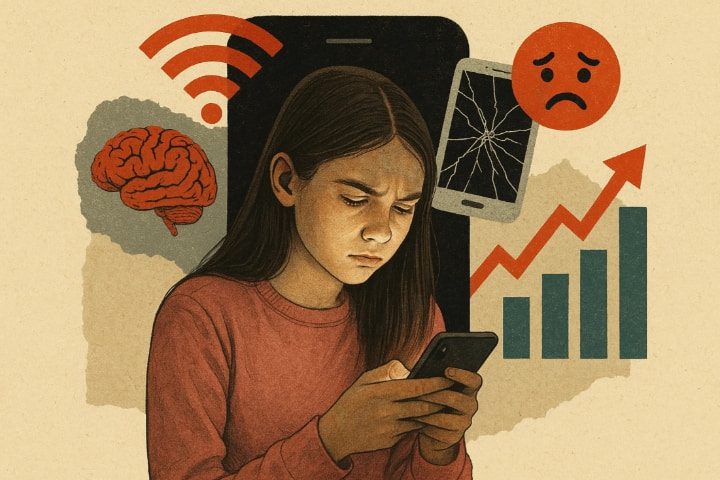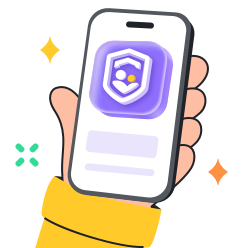In a world that is becoming more and more digitized, there is a new, quiet but serious health crisis that is starting to present itself among adolescents: screen addiction.
What would initially be viewed as an innocuous pastime or an easy escape can gradually turn into ubiquitous addiction. In turn, this would have disturbing implications on the physical and psychological health of many teens.
This article will discuss the emerging epidemic of screen addiction and how it is affecting the well-being of teens. As well as what parents can do to promote healthier screen behaviours.
What is screen addiction?



Screen addiction, also known as digital dependency, refers to an uncontrollable urge to spend time using digital devices until it becomes detrimental to everyday life. It is prescribed by inability to regulate screen time, placing it above duties, relationships, or even physical and mental health. A screen addicted teen gets anxious when they are unable to use their devices and fall behind on their other responsibilities like school work. The pattern interferes with mental health and social relations, forming a loop that is hard to overcome without external support.
Screen time vs. Screen addiction – what’s the difference?
Screen time is not necessarily bad; it all depends on the context.
There are healthy ways to use screens, such as to do homework or work on artistic activities. Such activities complement learning processes or social connections without taking precedence in the life of a teenager. Screen addiction, on the contrary, is related to harmful behavior like, scrolling through social media constantly or late-night gaming. This, in turn, interferes with sleep, focus, or relationships.
The main distinction, therefore, is in the screen use. It is in whether the screen time promotes or interferes with the welfare and everyday functioning of a teen.
Age-based screen time recommendations
The recommended guidelines on screen time by the American Academy of Pediatrics (AAP) depend on the age of a child.
- Children under the age of 18 months. Avoid screen media completely with the exception of video-chatting. This exception is for connecting with family members, since it is interactive social engagement.
- Small children, (18–24 months). Screen time must be limited and contain nothing but high-quality programming with a caregiver present and supervising the process.
- Pre-schoolers (2–5 yrs). Aim at limiting the screen use to one hour a day of quality content. Parents are expected to co-watch and assist the children in applying what they are watching to the real world.
- School age children (6-12 years). AAP does not establish a strict limit of hours per day, but it advises establishing a predictable schedule of screentime. Give priority to such things as sleep, physical play, homework, and family time.
- Teens (13 -18 years). There should be no interference of screen time with sleep, physical activity and real-life interactions. Promote media literacy and a frequent “device-free” time off.
These guidelines ensure that parents promote good digital behaviors among kids. Nevertheless, the neglect of such rules can result in children developing an addiction to screens.
Use parental controls to protect teens from screen addiction.
Symptoms of screen addiction in kids & teen
Identifying the signs of screen addiction early may assist parents in addressing this addiction before it becomes a bigger problem. Although little screen time is okay, a few behavioral and emotional shifts could be signs of increasing addiction.
Be on the lookout for the following screen addiction symptoms.
- Lack of interest in the offline life. They may drop hobbies, sporting activities or social activities that they previously enjoyed.
- Disregard of duties. Failure to complete household responsibilities, or refusal to engage with family members in order to spend time at the screen.
- Sleep disturbances. Late-night use of devices, which leads to tiredness, lack of concentration or temperament in the daytime.
- Obsessive behavior. Being obsessed with the thought of when they can be back on their phone even at meal time.
- Loss of real life social skills. Having difficulties with face-to-face communication or choosing online interactions over real interpersonal relations.
In case your child exhibits most of these symptoms on a regular basis, it could be indicative of his or her screen addiction and they require help to restore balance.
But what in the first place is making teens become so addicted to their screens. In the following section, we shall explore the reasons why teens are getting addicted to their screens.
Causes of teens indulging in screen
There are several psychological, social, and technological factors that make screens so addictive. These factors combine to make teens extremely vulnerable to screen addiction. Knowing what attracts adolescents to screens can allow parents to eliminate the causes of screen addition. As well as helps them influence their children to adopt healthier practices.
The following are the key drivers
Social validation on social media
Adolescents are desperate to belong and be accepted. Instagram, TikTok and Snapchat social media apps, therefore, offer immediate gratification in the form of likes and comments.
This social validation evokes the feeling of worth in internet engagement. And as a consequnce, it leads to compulsive checking and posting that results in screen addiction.
Dopamine hits from gaming
Video games, particularly those with rewards, activate the dopamine system of the brain, producing feelings of both pleasure and anticipation.
This neuro “high” is what keeps adolescents addicted, as they chase the next reward, making gaming one of the biggest contributors to screen addiction.
Algorithms designed to hook attention
To provide maximum engagement, tech companies use high-tech algorithms that cater to personal preference and keep teenagers scrolling.
Options like endless scrolling, auto-playing videos, and personal suggestions make them difficult to resist, which directly contributes to screen addiction.
Escapism and stress relief
Screens provide a relief from the pressures of the world, such as stress during school, social anxiety, or family issues.
However, when overdone, teens can end up getting addicted to their screens as a means to get through their problems.
What age group is most vulnerable to screen addiction?
Screen addiction may happen to kids and teens of any age. However, it seems that early adolescents (generally teens aged 10 to 14) are at the highest risk of getting addicted.This is a stage when the brain is most vulnerable. It is when teens are struggling to find themselves, and when they are vulnerable to emotional appeals of digital content. Their executive function, which influence impulse control and decision-making processes are normally not matured. And as a result, they cannot effectively control compulsive screen use.
However, Research also suggests that video game addiction might be at peak risk at ages 15-25 because of increased access to screens. Children below 10 years old who get over two hours of screentime also exhibit a greater predisposition towards addiction.
But, all in all, although every age group is exposed to risks, several factors combine to make early teenagers the most vulnerable group to screen addiction.
What are consequences if minors are addicted to screen?
Screen addiction among minors has far-reaching consequences, which may have a tremendous effect on their development, health, and well-being. Such effects can be especially harmful considering that children and adolescents are at a risky period of development.
The following is an account of both short-term and long-term effects.
Short-term effects
- Sleep disruption. Too much screen time and in particular at night disrupt the production of melatonin. This results in poor sleep and feeling tired all the time.
- Decline academic performance. Screen time tends to substitute homework or study time, which leads to decreasing grades and inability to concentrate.
- Mood changes. Minors addicted to screens might end up developing anxiety, and withdrawal symptoms particularly when access to the gadget is restricted.
Long-term effects
- Dysfunctional social skills. Excessive use of online communication may get in the way of social development in real life situations. Face-to-face communication may become uncomfortable or awkward.
- Mental health problems. The excessive use of a screen has been associated with higher chances of developing depression, low self-esteem, and emotional dysregulation.
- Less life satisfaction. Addiction may also cause one to lose touch with authentic activities and relationships with people. This may impact their general happiness and well-being over time.
It is vital to detect these risks early enough. As well as address them in time in order to safeguard the health and future development of a child.
Solutions to help kids break free from screen addiction
To stop the loop of screen addiction, it is important to have a mindful, sustainable strategy that needs to strike the balance between structure and understanding.
The following are strategies that parents can apply.
- Set time limits for the screen. Create screen time limits according to the recommended ages. Ensure that children know when and how long they can use their devices for.
- Promote offline programs. Assist your kid to identify other activities that are screen-free such as reading, sports, arts or outdoor game. This is to provide alternative healthy choices of entertainment and relaxation.
- Be an example of balanced digital behavior. Children tend to follow what they see. Model healthy screen use yourself in order to let your children know what is expected.
- Make communication open. Discuss screen time, internet life and online pressures on a regular basis. Listening to their point of view and acting on it will establish trust and promote collaboration as opposed to resistance.
Together with this, Digital well-being tools and parental control apps can also be critical in assisting families with screen addiction problems.
FlashGet Kids is one such effective option, providing a comprehensive set of features that target the needs of children.



Its functionalities help prevent screen addiction in the following ways.
- Screen Time. The option enables parents to impose time limits for use on the entire device or just individual applications. This will reduce compulsive use and create time to do other things.
- App Blocker. Parents can block apps or app categories that are considered as inappropriate or overly addictive using this feature.
- Alerts. Alerts parents in real-time about kids activities, like when a kid attempts to view a blocked app, or if they try to circumvent restrictions.
- Daily Usage Reports. Get in-depth reports that outline the digital habits of your child. This is so that you can identify trends and make necessary changes accordingly.
By using intelligent tools like FlashGet Kids, parents will be able to help their children establish better relationships with technology.
Bottom line
Screen addiction is a contemporary health issue specific to this digital age, but it is not impossible to deal with. By being more aware, having open discussions and putting in place effective boundaries, families can assist teenagers to shed the shackles of screen addiction.
Parents also have a crucial role in helping children to develop mindful use of technology. This is so that screens become positive tools for development. With balanced digital habits, families can easily overcome this new frontier of screen addiction and equip their children with the tools they require to be successful.
FAQs
There is no set amount. However, over 4-6 hours of non-essential screen time per day, especially if it disrupts sleep, school, or social life is a possible sign of screen addiction. This is especially when a child gets irritable when they cannot use the screen.
Yes, there are such tools as FlashGet Kids that can assist parents in managing screen time. It offers all-round solutions like screen time and screen mirroring for tracking device use and developing safer habits in kids.
When time spent in front of a screen is more than 2-3 hours a day, it could be too much. If the screen time replaces physical activity, sleep or social time, it is time to reevaluate use patterns.

